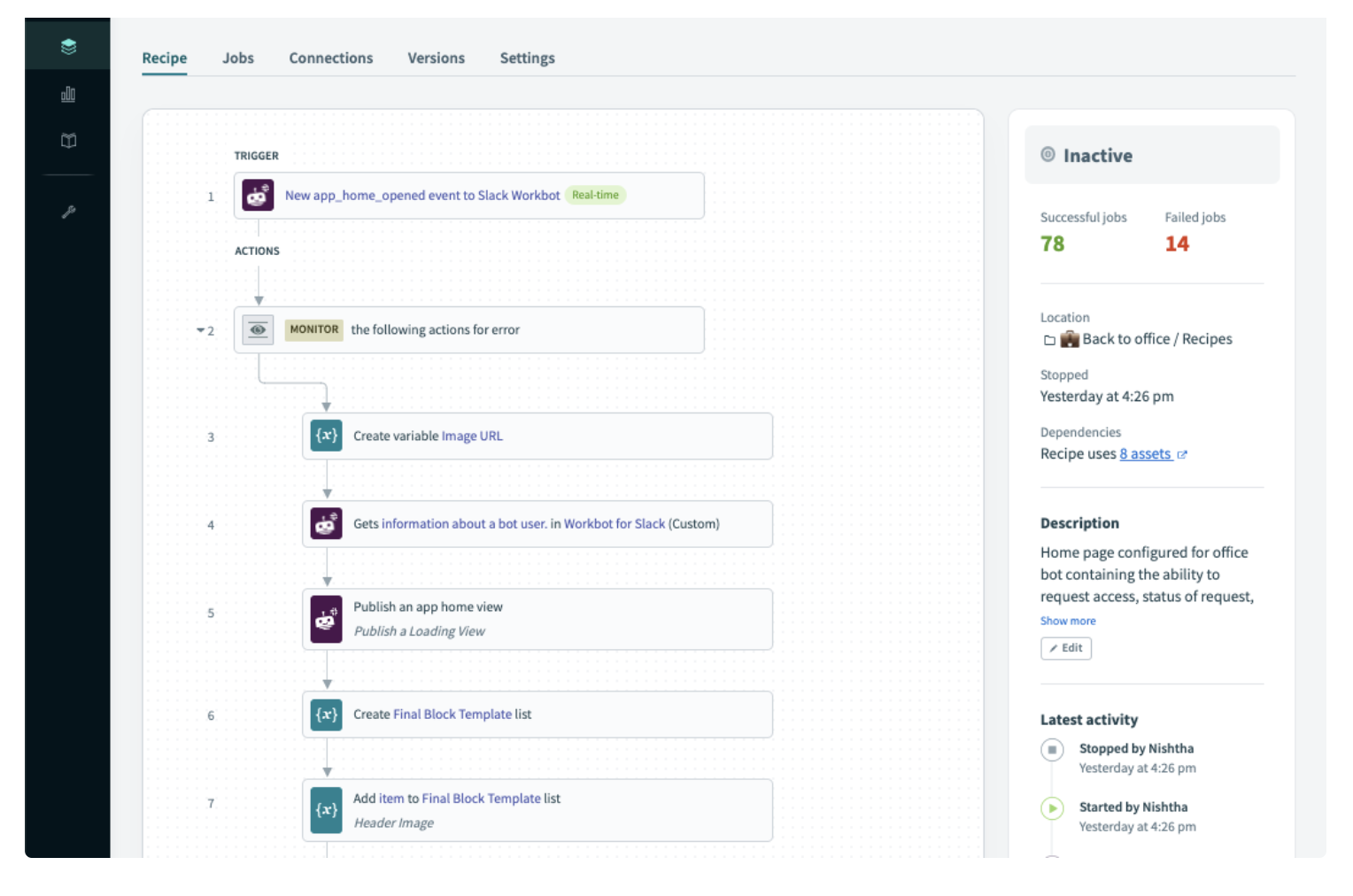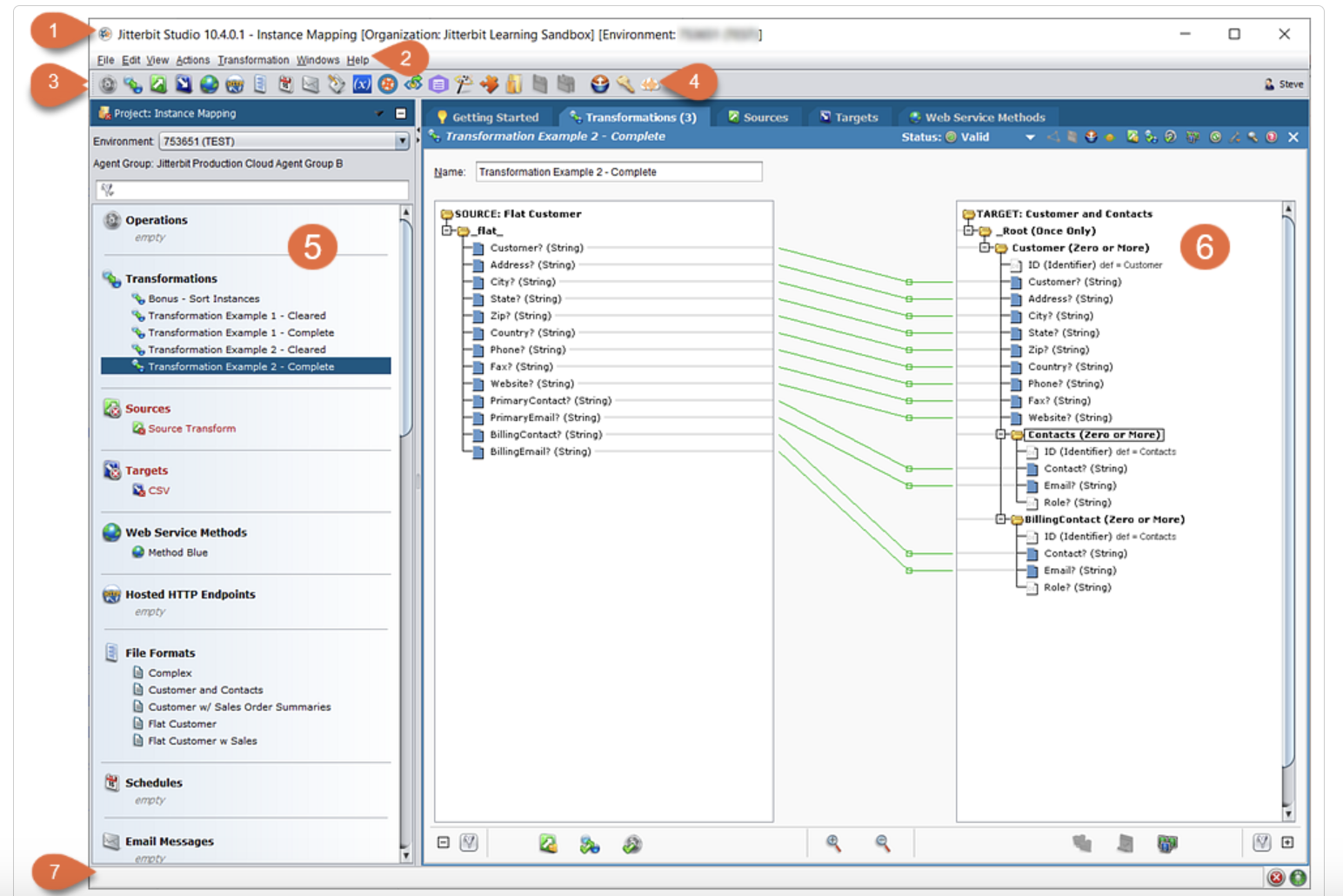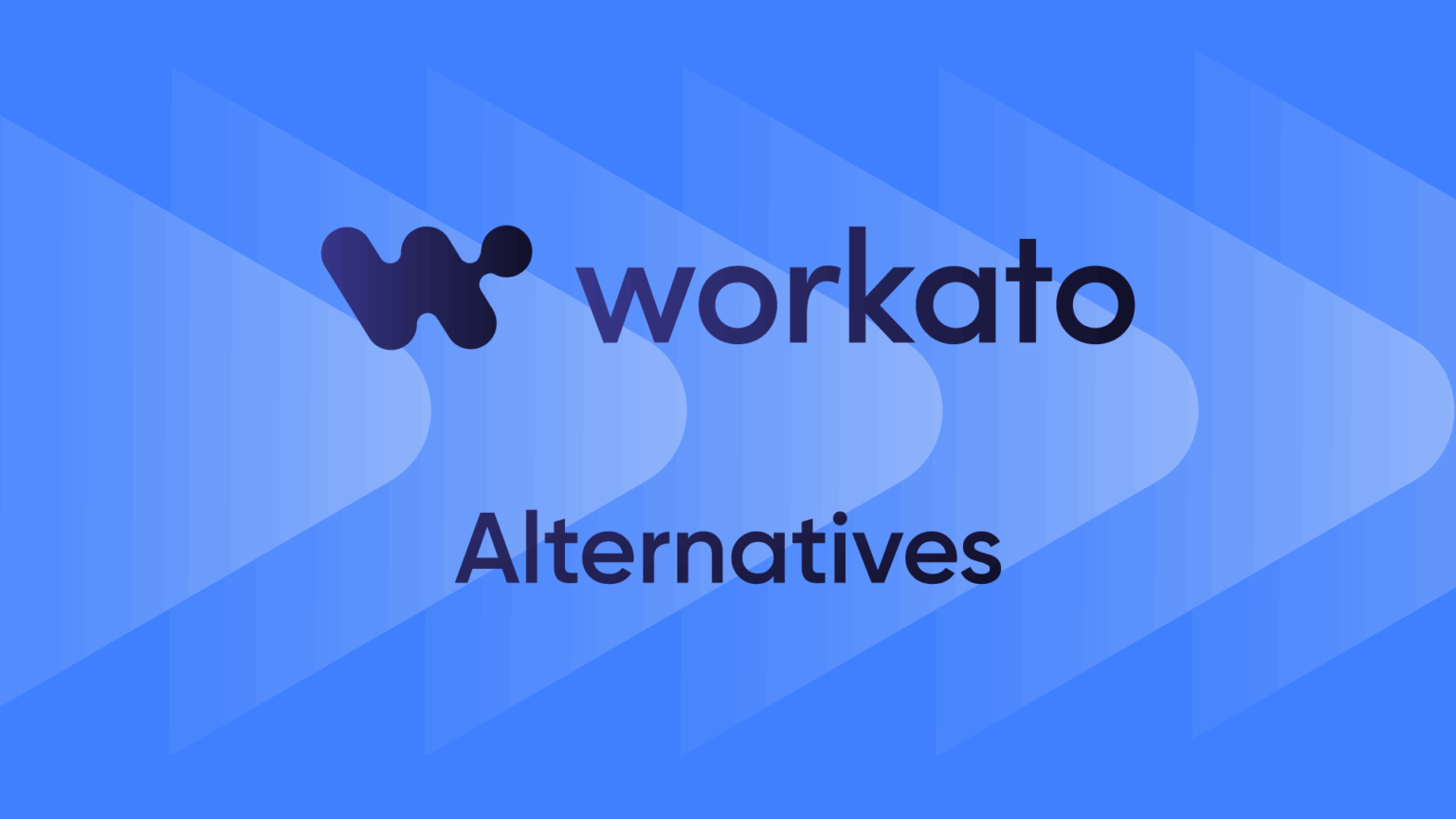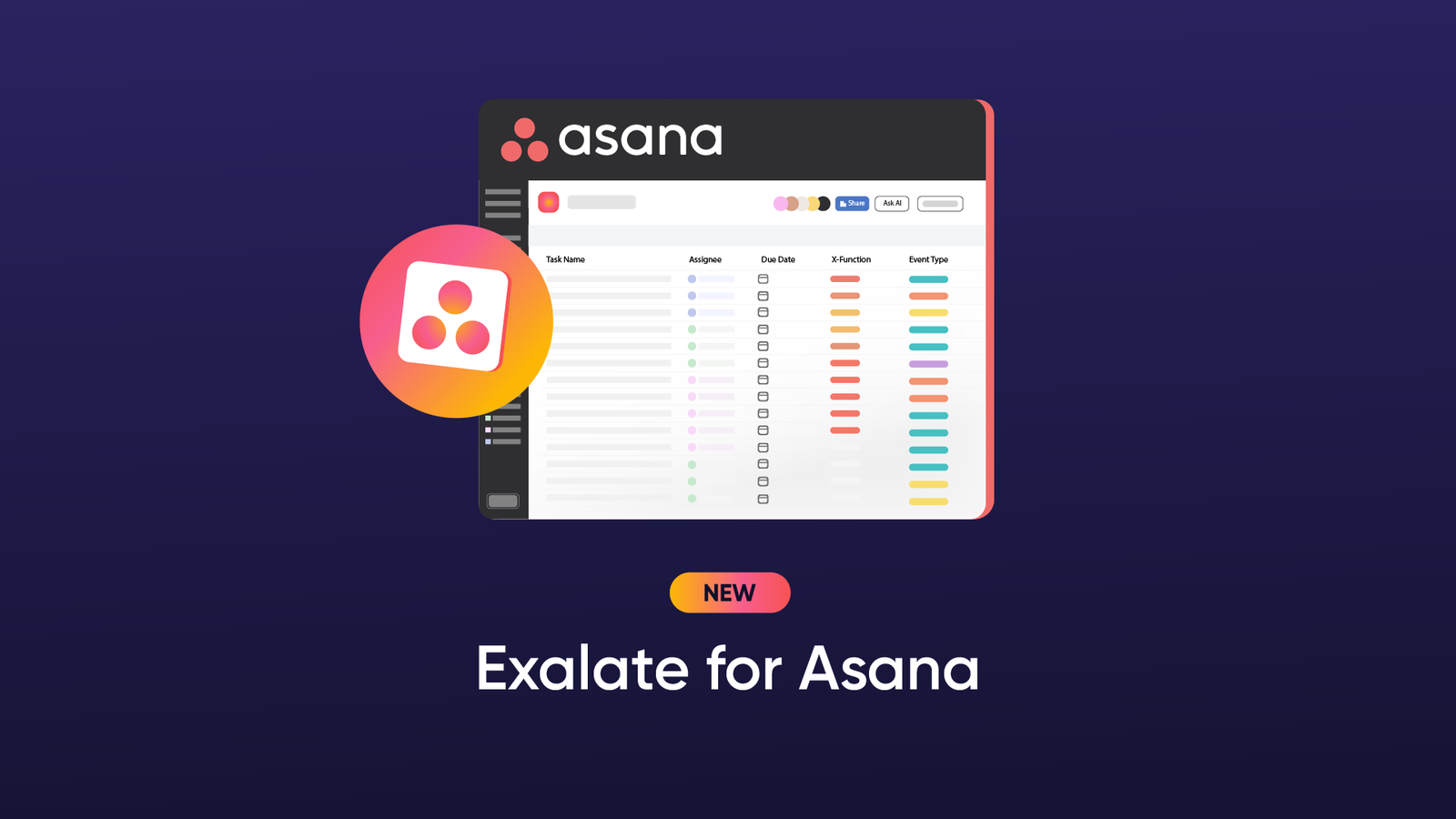When you’re in the market for Workato alternatives, consider solutions that can deliver the same level of flexibility, customizability, stability, and scalability.
With the market saturated with integration solutions, picking the best Workato alternative would be like a treasure hunt on an archipelago.
In this article, I’ve covered Workato’s features and limitations to provide context for comparison and outlined the best Workato alternatives in the marketplace.
What is Workato?
Workato is an integration platform that enables users to automate connections between applications, databases, workflows, cloud services, and communication tools.

On the surface, Workato is an integration tool. But it offers more than plug-and-play integrations. It also offers API and bot management and a data hub.
Let’s go through the features in detail.
What Features Does Workato Have?
Workato automation offers the following features and components.
- Pre-built connectors
- User-friendly interface
- Event triggers, actions, and automation logic
- Workflow bots
- B2B/EDI
- Enterprise iPaaS
- Data orchestration
- Data Hub/MDM
- App connectors
- Generative AI tools (Process AI, Workato Agentic, Copilots, IT Genie.)
The feature list shows that Workato offers way more than simple integrations, which makes it a popular choice for organizations like Booking, CISCO, Monday, NOKIA, etc.
In addition, Workato supports connectors for over 1000 apps, including HR, accounting, DevOps, and machine learning systems.
What Are the Limitations of Workato?
Despite the popularity of Workato, customers have reported some flaws and challenges experienced when using the integration tool.
Workato struggles with complex data import/export between disparate systems, which can be an extra headache for admins handling large data volumes.
The pricing might not fit small organizations looking for simple integration solutions. It is more suited for large organizations with massive budgets.
Since Workato is cloud-based, you can’t access it offline. Besides, it requires extensive programming (Ruby) experience to configure and use.
Even with the vast library of pre-built connectors, Workato offers little to no customization opportunities for users looking for niche requirements and use cases.
You might end up having to work with the universal connector, which could turn into a massive chore for your IT team.
Things to Consider When Choosing Workato Alternatives
Having understood the limitations, here are things to consider when choosing alternatives to Workato.
- Current business goals in alignment with the specific use case
- Cost of licensing, onboarding, and subscription
- The learning curve for system administrators
- User-friendliness of the interface
- Accuracy of data transformations
- Scalability and flexibility to handle changing workloads
- Availability of security and privacy features
- The presence of a reliable error-handling mechanism
- Customization options, as well as ready-to-use templates for connections
- Platform support, community, and documentation.
Using this checklist will help you choose the best Workato alternative that aligns with your business requirements and budget.
The Best Workato Alternatives
Let’s go through some Workato competitors that can serve as viable alternatives.
Tray.ai
Tray is an AI-powered integration platform that provides an automation cloud for connecting business processes.
This solution uses event triggers and automation to connect apps and streamline workflows between organizations and systems.
You can set up your own connections or work faster with reusable templates from the extensive Tray library.
Tray.ai Features
- Connector Hub
- Data integration
- API management
- Merlin Intelligence
- Enterprise core
- Event-based automation
Tray.ai Pros
- Tray provides a massive library of connectors for different platforms and systems.
- Tray uses AI features to speed up the configuration of connectors.
- It provides a user-friendly interface for setting up connections.
- It supports triggers for automating processes.
Tray.ai Cons
- The error-handling mechanism is challenging to navigate.
- The pre-built connectors are difficult to customize.
- You can’t test connections before deployment.
Exalate
Exalate supports bidirectional synchronization between systems in order to enable them to exchange data. It supports various popular platforms like Jira, Salesforce, Azure DevOps, ServiceNow, etc.
Exalate’s Script mode is based on a powerful scripting engine that can be used to implement the trickiest use cases.
AI Assist in Script mode relies on human prompts to generate reliable and accurate sync scripts. This reduces the time spent writing a script from scratch or searching for the relevant one.
You can check out the Trust Center for more information about security, or just read about it in the Exalate Security Whitepaper.
Exalate Features
- Intuitive and robust scripting engine
- Enhanced security through decentralized integration and single-tenant architecture
- Monitoring dashboard for tracking connections on your node
- Integrated retry mechanism
- Error console
- Groovy scripting engine
- AI Assist
- Platform native event triggers
Exalate Pros
- It allows users to customize their sync configurations to a granular level and sync almost any data they want.
- It uses an AI-powered assistant to generate and suggest sync scripts.
- Its single-tenant yet distributed architecture keeps your system isolated and secure.
- Exalate triggers facilitate real-time, event-based actions.
- The support is extensive and impressive.
- Exalate is way more affordable than Workato.
Exalate Cons
- Exalate supports only a handful of applications as compared to Workato but allows deep integrations via its scripting engine.
- As with any AI, the AI Assist feature still needs close supervision.
- You need to have a basic knowledge of the Groovy language to use the code-based console but with the AI Assist feature the learning curve is simpler.
Boomi
Boomi is an iPaaS solution that supports the integration of internal and external workflows and business processes.
Beyond simple integration, Boomi also supports data management, API management, intelligent integration mapping, error testing, and multi-source consolidation.
Boomi Features
- API management
- B2B/EDI management
- Master Data Hub
- Event Streams
Boomi Pros
- Boomi has a supportive community.
- It supports over 200,000 connector variations.
- It can be deployed in private or public cloud platforms.
- It provides multiple templated integrations.
Boomi Cons
- It struggles to support multiple connectors.
- Boomi’s API management is limited to basic functionality.
- The pricing structure might not be the best fit for small businesses.
- The error reporting is subpar.
Mulesoft Anypoint Platform
Mulesoft, owned by Salesforce, is the native integration solution for synchronizing data between Salesforce and other platforms.
Its integration solution, Mulesoft Anypoint Platform, supports the creation of connectors, APIs, and workflows.
Mulesoft Anypoint Platform Features
- Pre-built connectors
- Custom integrations
- Anypoint CLI
- API Governance
- Flex Gateway
- Studio
- API Designer
- Partner Manager
- Code Builder
- etc.
Mulesoft Anypoint Platform Pros
- It gives you access to other Salesforce CRM tools.
- You can adapt it to your use case.
- It centralizes the development, monitoring, and deployment of APIs and integrations.
- It provides a massive library of template connectors.
Mulesoft Anypoint Platform Cons
- It requires an extensive understanding of the Salesforce architecture to use.
- It has many vestigial features that you never get to use.
- It is too Salesforce-centric.
SnapLogic
Users working with SnapLogic get access to a low-code integration platform for creating and automating business processes and workflows.

Although SnapLogic focuses on system integration, it also supports API creation and management.
With a comprehensive library of over 700 pre-built connectors or “Snaps”, IT admins can unify their SaaS sprawl.
SnapLogic Features
- SnapLogic AutoSync
- GenAI Builder
- API Management (APIM)
- AutoSuggest
- AutoPrep
- Snaps (pre-built connectors)
- ELT/ETL
SnapLogic Pros
- It provides a vast library of pre-built Snaps.
- It uses AI solutions like SnapGPT to improve the quality of connections.
SnapLogic Cons
- The interface often lags and crashes.
- The error handling mechanism is too complex.
Zapier
Zapier provides a drag-and-drop builder for setting up integrations between systems and organizations.

With Zapier as the Workato alternative, companies can boost operational and workflow efficiency, as well as automate manual tasks.
Zapier also supports Zaps with over 6000 apps, making it the go-to solution for companies looking for affordable, no-code connectivity.
Zapier Features
- Zaps (automated connections)
- Tables
- Interfaces (custom pages)
- Canvas (AI-powered workflow mapping)
- Chatbots
Zapier Pros
- Zapier is accessible for users without advanced technical experience.
- It supports event-based automation.
- It supports more connectors than Workato.
Zapier Cons
- You need to pay extra to access advanced connections.
- It doesn’t support ongoing bidirectional integration.
- Zaps can malfunction during important integration or migration scenarios.
Jitterbit Harmony
This iPaaS solution supports low-code integration between applications and cloud services. Jitterbit supports API management and low-code application development.

Jitterbit Harmony integration grants you access to over 400 templates for connecting and automating workflows and business logic.
Jitterbit Harmony Features
- IPaaS
- EDI
- API Manager
- App Builder
- Salesforce Data Loader
Jitterbit Harmony Pros
- It supports Extract, Transform, Load (ETL).
- It allows you to build and customize APIs.
- The platform is user-friendly and intuitive.
Jitterbit Harmony Cons
- The learning curve is steep.
- It doesn’t support version control and event logs.
- Only large corporations can afford it.
Informatica
This enterprise data management platform allows users to sync data and systems in order to consolidate and orchestrate workflows.

Informatica uses AI capabilities to speed up integrations and optimize connections in order to eliminate human error and data duplication.
Informatica Features
- Data Catalog
- Data Integration & Engineering
- Data Marketplace
- API & App Integration
- Data Quality & Observability
- MDM & 360 Applications
- Governance, Access & Privacy
- CLAIRE AI Engine
Informatica Pros
- It is applicable across multiple industries and processes.
- It supports in-depth data integration between multiple platforms.
- Informatica supports complex information lookup and data transformation.
- The interface is user-friendly.
Informatica Cons
- You have to handle data quality management manually.
- The pricing model is too complex.
- You can only generate mappings through a GUI without writing code.
Celigo
Celigo is a popular option among other Workato alternatives because it offers drag-and-drop features and advanced scripting capabilities.
As a Workato alternative, Celigo offers a vast library of connection templates, which you can use as a jumping-off point.
Celigo Features
- Celigo AI
- API Management
- Error Management
- B2B Manager
Celigo pros
- It provides a vast library of templated connectors.
- It provides clear integration backlogs.
- Celigo has a dedicated error management feature.
Celigo cons
- Celigo has fewer enterprise features than Workato.
- It has a limited product offering.
ONEiO
ONEiO provides an iPaaS solution that centralizes the connection of tools and integration of processes.
As a Workato alternative, this solution provides a fully managed interface for setting up connections between applications and services.
ONEiO Features
- Over 10,000 applications by default.
- No-code editor
- Attachment handling.
- Data anonymization and transformation.
ONEiO Pros
- It provides a stacked library of connectors.
- The editor supports no-code connections.
ONEiO Cons
- You cannot deploy ONEiO on-premise.
- It doesn’t have API management capabilities.
- The partner network is small compared to Workato.
Why Exalate is an Excellent Workato Alternative
Exalate is one of the best Workato alternatives on the market when it comes to integrating data bidirectionally between systems.
The Exalate integration as a service option allows users to connect with Salesforce CRM, ServiceNow, GitHub, Jira (Cloud, On-Premise, and Data Center), Zendesk, and Azure DevOps.
In addition to these main connectors, you can request custom connectors and solutions from scratch for specific service desk applications and CRMs.
MSPs can also use Exalate to improve collaboration with clients. This could be a bidirectional sync with a supplier or deep-ticket integration with a cybersecurity MSP.
Exalate’s crown jewel is the AI-powered Groovy-based scripting engine that allows you to configure your scripts and map connections however you want. You can also set triggers for action-based synchronization.
To find out more about Exalate and how it can help your use case, book a demo with our engineers right away.
Recommended Reading:
- Exalate Comparisons with other tools like Getint, Zigiops, Unito, etc.
- Exalate or Getint: An Objective Comparison to Help You Choose the Best Integration Solution
- The Best MuleSoft Alternatives for Business Process Integration
- 10 Most Valuable Integrationhub Alternatives Right Now
- ITSM Integration: Simplify Your IT Services Like Never Before
- Exploring the Build vs. Buy Integration Debate



